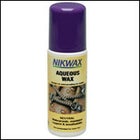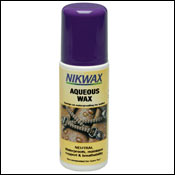Im here to make your life simpler, which I will now do. Think of your boots as sort of a second skin for your feet. Like your real skin, you want to keep the boots reasonably clean and reasonably moist. You dont want to scrub them too hard, dry them with too much heat, or grease them up too much.
Nikwax Aqueous
 Aqueous waterproofing
Aqueous waterproofingSo heres the drill. When your boots start to get real grubby on the outside, from mud and dust, rinse them off with cool water. Use a soft brush to gently clean the seams to get abrasive grit out of the tight spots. Rinse the interiors, too, as sweat has an acidic component that can damage linings, particularly the newer fabric linings. Towel-dry the boots and let them fully dry at more or less room temperature.
Factory-fresh boots have a good dose of conditioning and waterproofing in the leather, so you dont need to do too much right away. Maybe spritz them with a little Nikwax Aqueous ($7.50; www.nikwax.com), an easy-to-use water-repellent that also gives the leather a little conditioning.
As time goes on you do want to guard against the leather drying out. After cleaning, apply something like Grangers water-based G-Wax ($7.50; www.grangersusa.com), which helps condition and protect the leather. Nikwaxs Leather Conditioner (also $7.50) is good stuff, too. Dont use any grease or oil such as mink oil.
You can buy special boot cleaners” and so on, but Im not sure Id bother. Water removes 99 percent of what youll collect on a trail. In cases of extreme boot filth, a little Dawn detergent wouldnt hurtits an excellent de-greaser and fairly mild. Bird-rescue people use it after oil spills.
With reasonable care, even benign neglect, good leather boots should last many years, and the leather should survive two or even three sole replacements. March on!
Youve got your winter gear, now get outside and use it. makes it easy to find nearby slopes just begging for fresh tracks.


